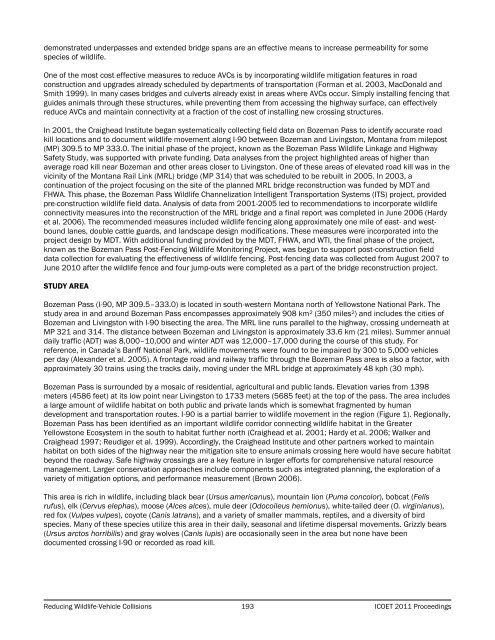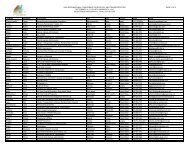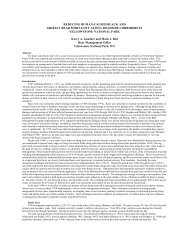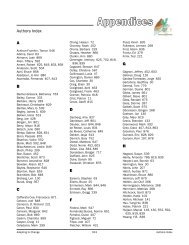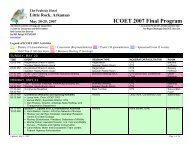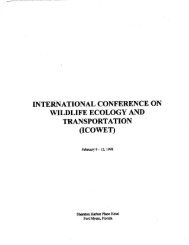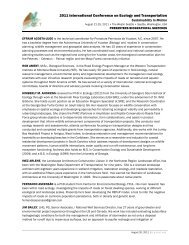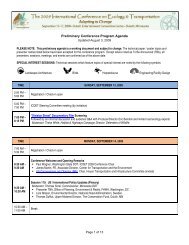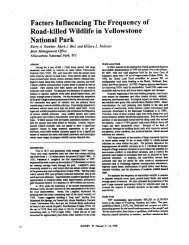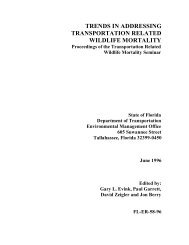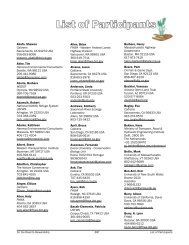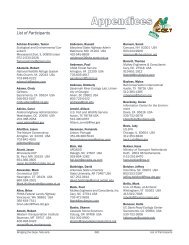COM-1, pages 179-226 - ICOET
COM-1, pages 179-226 - ICOET
COM-1, pages 179-226 - ICOET
You also want an ePaper? Increase the reach of your titles
YUMPU automatically turns print PDFs into web optimized ePapers that Google loves.
demonstrated underpasses and extended bridge spans are an effective means to increase permeability for somespecies of wildlife.One of the most cost effective measures to reduce AVCs is by incorporating wildlife mitigation features in roadconstruction and upgrades already scheduled by departments of transportation (Forman et al. 2003, MacDonald andSmith 1999). In many cases bridges and culverts already exist in areas where AVCs occur. Simply installing fencing thatguides animals through these structures, while preventing them from accessing the highway surface, can effectivelyreduce AVCs and maintain connectivity at a fraction of the cost of installing new crossing structures.In 2001, the Craighead Institute began systematically collecting field data on Bozeman Pass to identify accurate roadkill locations and to document wildlife movement along I-90 between Bozeman and Livingston, Montana from milepost(MP) 309.5 to MP 333.0. The initial phase of the project, known as the Bozeman Pass Wildlife Linkage and HighwaySafety Study, was supported with private funding. Data analyses from the project highlighted areas of higher thanaverage road kill near Bozeman and other areas closer to Livingston. One of these areas of elevated road kill was in thevicinity of the Montana Rail Link (MRL) bridge (MP 314) that was scheduled to be rebuilt in 2005. In 2003, acontinuation of the project focusing on the site of the planned MRL bridge reconstruction was funded by MDT andFHWA. This phase, the Bozeman Pass Wildlife Channelization Intelligent Transportation Systems (ITS) project, providedpre-construction wildlife field data. Analysis of data from 2001-2005 led to recommendations to incorporate wildlifeconnectivity measures into the reconstruction of the MRL bridge and a final report was completed in June 2006 (Hardyet al. 2006). The recommended measures included wildlife fencing along approximately one mile of east- and westboundlanes, double cattle guards, and landscape design modifications. These measures were incorporated into theproject design by MDT. With additional funding provided by the MDT, FHWA, and WTI, the final phase of the project,known as the Bozeman Pass Post-Fencing Wildlife Monitoring Project, was begun to support post-construction fielddata collection for evaluating the effectiveness of wildlife fencing. Post-fencing data was collected from August 2007 toJune 2010 after the wildlife fence and four jump-outs were completed as a part of the bridge reconstruction project.STUDY AREABozeman Pass (I-90, MP 309.5–333.0) is located in south-western Montana north of Yellowstone National Park. Thestudy area in and around Bozeman Pass encompasses approximately 908 km 2 (350 miles 2 ) and includes the cities ofBozeman and Livingston with I-90 bisecting the area. The MRL line runs parallel to the highway, crossing underneath atMP 321 and 314. The distance between Bozeman and Livingston is approximately 33.6 km (21 miles). Summer annualdaily traffic (ADT) was 8,000–10,000 and winter ADT was 12,000–17,000 during the course of this study. Forreference, in Canada’s Banff National Park, wildlife movements were found to be impaired by 300 to 5,000 vehiclesper day (Alexander et al. 2005). A frontage road and railway traffic through the Bozeman Pass area is also a factor, withapproximately 30 trains using the tracks daily, moving under the MRL bridge at approximately 48 kph (30 mph).Bozeman Pass is surrounded by a mosaic of residential, agricultural and public lands. Elevation varies from 1398meters (4586 feet) at its low point near Livingston to 1733 meters (5685 feet) at the top of the pass. The area includesa large amount of wildlife habitat on both public and private lands which is somewhat fragmented by humandevelopment and transportation routes. I-90 is a partial barrier to wildlife movement in the region (Figure 1). Regionally,Bozeman Pass has been identified as an important wildlife corridor connecting wildlife habitat in the GreaterYellowstone Ecosystem in the south to habitat further north (Craighead et al. 2001; Hardy et al. 2006; Walker andCraighead 1997; Reudiger et al. 1999). Accordingly, the Craighead Institute and other partners worked to maintainhabitat on both sides of the highway near the mitigation site to ensure animals crossing here would have secure habitatbeyond the roadway. Safe highway crossings are a key feature in larger efforts for comprehensive natural resourcemanagement. Larger conservation approaches include components such as integrated planning, the exploration of avariety of mitigation options, and performance measurement (Brown 2006).This area is rich in wildlife, including black bear (Ursus americanus), mountain lion (Puma concolor), bobcat (Felisrufus), elk (Cervus elephas), moose (Alces alces), mule deer (Odocoileus hemionus), white-tailed deer (O. virginianus),red fox (Vulpes vulpes), coyote (Canis latrans), and a variety of smaller mammals, reptiles, and a diversity of birdspecies. Many of these species utilize this area in their daily, seasonal and lifetime dispersal movements. Grizzly bears(Ursus arctos horribilis) and gray wolves (Canis lupis) are occasionally seen in the area but none have beendocumented crossing I-90 or recorded as road kill.Reducing Wildlife-Vehicle Collisions 193 <strong>ICOET</strong> 2011 Proceedings


